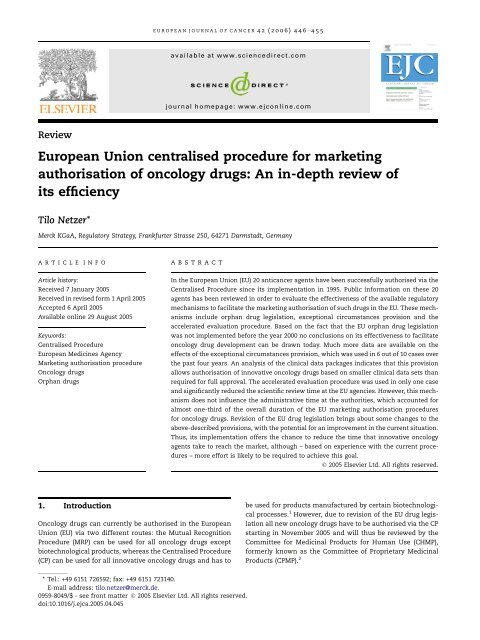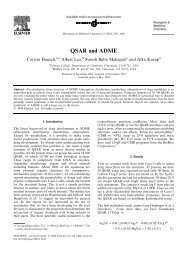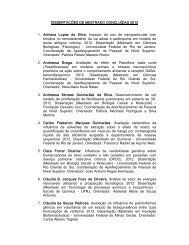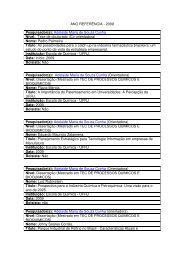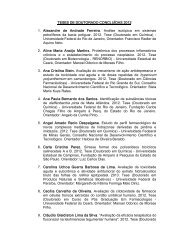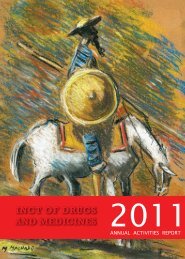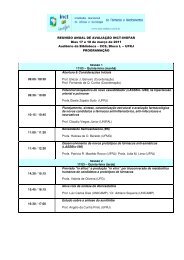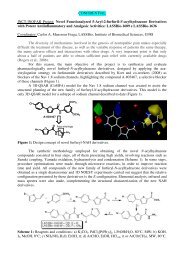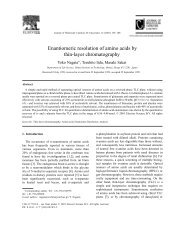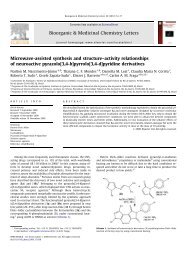European Union centralised procedure for marketing ... - INCT-Inofar
European Union centralised procedure for marketing ... - INCT-Inofar
European Union centralised procedure for marketing ... - INCT-Inofar
Create successful ePaper yourself
Turn your PDF publications into a flip-book with our unique Google optimized e-Paper software.
E U R O P E A N J O U R NA L O F CA N C E R42 (2006) 446– 455available at www.sciencedirect.comjournal homepage: www.ejconline.comReview<strong>European</strong> <strong>Union</strong> <strong>centralised</strong> <strong>procedure</strong> <strong>for</strong> <strong>marketing</strong>authorisation of oncology drugs: An in-depth review ofits efficiencyTilo Netzer*Merck KGaA, Regulatory Strategy, Frankfurter Strasse 250, 64271 Darmstadt, GermanyARTICLEINFOABSTRACTArticle history:Received 7 January 2005Received in revised <strong>for</strong>m 1 April 2005Accepted 6 April 2005Available online 29 August 2005Keywords::Centralised Procedure<strong>European</strong> Medicines AgencyMarketing authorisation <strong>procedure</strong>Oncology drugsOrphan drugsIn the <strong>European</strong> <strong>Union</strong> (EU) 20 anticancer agents have been successfully authorised via theCentralised Procedure since its implementation in 1995. Public in<strong>for</strong>mation on these 20agents has been reviewed in order to evaluate the effectiveness of the available regulatorymechanisms to facilitate the <strong>marketing</strong> authorisation of such drugs in the EU. These mechanismsinclude orphan drug legislation, exceptional circumstances provision and theaccelerated evaluation <strong>procedure</strong>. Based on the fact that the EU orphan drug legislationwas not implemented be<strong>for</strong>e the year 2000 no conclusions on its effectiveness to facilitateoncology drug development can be drawn today. Much more data are available on theeffects of the exceptional circumstances provision, which was used in 6 out of 10 cases overthe past four years. An analysis of the clinical data packages indicates that this provisionallows authorisation of innovative oncology drugs based on smaller clinical data sets thanrequired <strong>for</strong> full approval. The accelerated evaluation <strong>procedure</strong> was used in only one caseand significantly reduced the scientific review time at the EU agencies. However, this mechanismdoes not influence the administrative time at the authorities, which accounted <strong>for</strong>almost one-third of the overall duration of the EU <strong>marketing</strong> authorisation <strong>procedure</strong>s<strong>for</strong> oncology drugs. Revision of the EU drug legislation brings about some changes to theabove-described provisions, with the potential <strong>for</strong> an improvement in the current situation.Thus, its implementation offers the chance to reduce the time that innovative oncologyagents take to reach the market, although – based on experience with the current <strong>procedure</strong>s– more ef<strong>for</strong>t is likely to be required to achieve this goal.Ó 2005 Elsevier Ltd. All rights reserved.1. IntroductionOncology drugs can currently be authorised in the <strong>European</strong><strong>Union</strong> (EU) via two different routes: the Mutual RecognitionProcedure (MRP) can be used <strong>for</strong> all oncology drugs exceptbiotechnological products, whereas the Centralised Procedure(CP) can be used <strong>for</strong> all innovative oncology drugs and has tobe used <strong>for</strong> products manufactured by certain biotechnologicalprocesses. 1 However, due to revision of the EU drug legislationall new oncology drugs have to be authorised via the CPstarting in November 2005 and will thus be reviewed by theCommittee <strong>for</strong> Medicinal Products <strong>for</strong> Human Use (CHMP),<strong>for</strong>merly known as the Committee of Proprietary MedicinalProducts (CPMP). 2* Tel.: +49 6151 726592; fax: +49 6151 723140.E-mail address: tilo.netzer@merck.de.0959-8049/$ - see front matter Ó 2005 Elsevier Ltd. All rights reserved.doi:10.1016/j.ejca.2005.04.045
E U RO P E A N J O U R NA L O F CA N C E R42 (2006) 446– 455 447An in-depth review was per<strong>for</strong>med evaluating the publiclyavailable in<strong>for</strong>mation on the <strong>marketing</strong> authorisation<strong>procedure</strong>s <strong>for</strong> those oncology products that have been successfullyauthorised via the CP since its establishment in1995. The main goal of this review was to evaluate theeffectiveness of the available mechanisms to acceleratethe <strong>marketing</strong> authorisation of oncology drugs in the EU.As clinical development is usually the time-limiting step<strong>for</strong> approval of innovative drugs, a thorough analysis ofthe clinical data packages <strong>for</strong> these products is also provided.Both analyses provide suggestions <strong>for</strong> futureimprovement of <strong>marketing</strong> authorisation <strong>procedure</strong>s <strong>for</strong>new oncology agents.There are currently three main mechanisms available inthe EU that may be used to facilitate the development andthe <strong>marketing</strong> authorisation process of oncology drugs: orphandrug legislation, exceptional circumstances provisionand the accelerated evaluation <strong>procedure</strong>.1.1. Orphan drug legislationIn the EU the orphan drug legislation was implemented in2000. 3 Orphan drugs have access to the so-called ‘ProtocolAssistance’ at the <strong>European</strong> Medicines Agency (EMEA), whichusually requires lower fees than the EMEA Scientific Advice.Additionally, orphan drugs qualify more easily <strong>for</strong> the exceptionalcircumstances provision (see below). Thus, orphandrug status is considered to facilitate development of drugs<strong>for</strong> treatment of less frequent cancers, such as gliomas, renalcell cancer or certain haematological tumours.An assessment of the usefulness of the orphan drug regulationcannot yet be made, as this regulation was not implementedin the EU be<strong>for</strong>e the year 2000.1.2. Exceptional circumstances provisionThe EU drug law, as currently codified in the Commission Directive2003/63/EC, 4 allows that a <strong>marketing</strong> authorisation may begranted based on a reduced development programme (e.g.based only on phase II studies) under so-called ‘exceptionalcircumstances’. These exceptional circumstances includedevelopment <strong>for</strong> use in a rare condition (e.g. orphan condition)or where in the present state of scientific knowledge, comprehensivein<strong>for</strong>mation cannot be provided or when it would beunethical to collect further data. For anticancer agents theCPMP Note <strong>for</strong> Guidance on Anticancer Medicinal Products 5 furtherexplains how to use these provisions in order to facilitate thedevelopment of oncology drugs. According to this guideline a<strong>marketing</strong> authorisation application can be based on datafrom uncontrolled clinical trials when there is no approvedtreatment available and an investigational drug shows outstandinganticancer activity. Additionally, this guideline endorsesthe use of tumour response as a surrogate endpoint,if it is justified to predict clinical benefit. Although this anticancerguideline provides no in<strong>for</strong>mation <strong>for</strong> development ofnon-cytotoxic agents it has been used <strong>for</strong> the assessment ofa number of such non-cytotoxic agents.Overall, the exceptional circumstances provision has beenused frequently over the past three years to facilitate the <strong>marketing</strong>authorisation of innovative oncology drugs in the EU.1.3. Accelerated evaluation <strong>procedure</strong>The EMEA first provided guidance 6 on an accelerated evaluationof products in 1996. This guidance <strong>for</strong>esaw a scientific reviewtime of 120 d instead of the standard 210 d <strong>for</strong> drugs thatmeet the following three cumulative criteria:• indicated <strong>for</strong> treatment of a heavily disabling or lifethreateningdisease and• absence of an appropriate alternative therapeuticapproach, and• anticipation of exceptionally high therapeutic benefit.Only one of the oncology drugs investigated has beenauthorised using an accelerated evaluation <strong>procedure</strong>.2. Materials and methodsThis review considered only new chemical or biological entitiesthat belong to the Anatomical Therapeutic Chemical(ATC) Code categories ‘L01 – Anti-neoplastic agents’ and‘L02 – Endocrine therapy’ and which the <strong>European</strong> Commissionauthorised <strong>for</strong> systemic anticancer treatment betweenJanuary 1995 (start of the CP) and 30th June 2004. Other drugsused <strong>for</strong> treatment of patients with cancer, such as colonystimulatingfactors, interferons and other immunomodulatorsas well as agents affecting bone structure and mineralisation(bisphosphonates), were not considered in order to ensurehomogeneity of the investigated drugs and thus reducevariability of the results. A list of all products considered <strong>for</strong>analysis is given in Table 1.Label extensions obtained after the initial <strong>marketing</strong>authorisations were not included in this analysis as they followdifferent <strong>procedure</strong>s, so-called variations. Additionally,the impact of such label changes on the availability of newoncology drugs <strong>for</strong> patients is limited because the drug is alreadycommercially available when a variation is submitted.For all the products investigated, three different areas ofin<strong>for</strong>mation were evaluated:1. Procedural in<strong>for</strong>mation: this includes the orphan drug status,exceptional circumstances status and acceleratedapproval status. It was extracted from the <strong>European</strong> PublicAssessment Reports (EPAR) which are published on thehomepage of the EMEA. 72. Timelines: timelines of the initial <strong>marketing</strong> authorisation<strong>procedure</strong> are defined <strong>for</strong> the purpose of this article as follows(see Fig. 1):• ‘Active time’ is the time needed <strong>for</strong> scientific evaluationby the CPMP as given in the Annual Reports of theEMEA. The Annual Reports of the EMEA can be retrievedfrom the EMEA homepage. 7• ‘Clock-stop time’ is the time needed by the applicant toanswer the objections raised by the authorities as givenin the Annual Reports of the EMEA.• ‘Scientific time’ is the time needed <strong>for</strong> scientific evaluationby the CPMP plus the time needed by the applicant<strong>for</strong> answering the authority objections; it wascalculated as the interval between the start of the
448 E U R O P E A N J O U R NA L O F CA N C E R42 (2006) 446– 455Table 1 – Evaluated oncology products sorted by date of first <strong>marketing</strong> authorisation (MA) in the <strong>European</strong> <strong>Union</strong> (EU)including procedural in<strong>for</strong>mationINN Trade name MA holder a Date of first MA Procedural in<strong>for</strong>mationDocetaxel Taxotere Rhone-Poulenc Rorer SA, France 27th November 1995 ECToremifene Fareston Orion Corporation, Finland 14th February 1996 N/ADoxorubicin HCl Caelyx SP Europe, Belgium 21st June 1996 N/ATopotecan Hycamtin SmithKline Beecham plc, UK 12th November 1996 N/ARituximab MabThera Hoffmann-LaRoche, UK 2nd June 1998 N/ATemozolomide Temodal SP Europe, Belgium 20th January 1999 N/ATasonermin (TNF alpha) Beromun Boehringer Ingelheim13th April 1999N/AInternational GmbH, GermanyPaclitaxel Paxene Norton Healthcare Ltd., UK 19th July 1999 N/ADoxorubicin HClMyocet The Liposome Company, UK 13th July 2000 N/A(liposome encapsulated)Trastuzumab Herceptin Roche, UK 28th August 2000 N/ACapecitabine Xeloda Roche, UK 2nd February 2001 N/ABexarotene Targretin Ligand Pharmaceuticals UK Ltd., UK 29th March 2001 N/AAlemtuzumab MabCampath Millenium and Ilex UK Ltd., UK 6th July 2001 ECTemoporfin Foscan Scotia Pharmaceuticals Ltd., UK 24th October 2001 ECImatinib Glivec Novartis Europharm Ltd., UK 7th November 2001 EC, OD, AEArsenic trioxide Trisenox Cell Therapeutics, UK 5th March 2002 EC, ODIbritumomab Zevalin Schering AG, Germany 16th Jan 2004 ECFulvestrant Faslodex AstraZeneca UK Ltd., UK 10th March 2004 N/ABortezomib Velcade Millenium Pharmaceuticals Ltd., UK 26th April 2004 ECCetuximab Erbitux Merck KGaA, Germany 29th June 2004 N/AINN, international non-proprietary name; EC, exceptional circumstances; OD, orphan drug; AE, accelerated evaluation; N/A, not applicable;MA, <strong>marketing</strong> authorisation.a At time of <strong>procedure</strong>.Fig. 1 – Overview on definitions of timelines. CPMP, Committee of Proprietary Medicinal Products.<strong>procedure</strong> and the CPMP opinion as given in the AnnualReports of the EMEA, i.e. theoretically the sum of theactive time and the clock-stop time; these times donot always sum up exactly to the total review timesdue to apparent different approximations used in thedifferent sources. Where discrepancies across reportswere noted, the time intervals were manuallyrecalculated.• ‘Administrative time’ is the time needed <strong>for</strong> translationand approval of the national product in<strong>for</strong>mation, andpublication of the Commission decision. Be<strong>for</strong>e thefinal Commission decision is released the draft Commissiondecision is also <strong>for</strong>warded to a regulatorycommittee called the ‘Standing Committee on MedicinalProducts <strong>for</strong> Human Use’ (Standing Committee)where representatives of the Member States have30 d to raise objections. If important objections areraised, the CPMP is asked to <strong>for</strong>mulate a reply, and anew Standing Committee <strong>procedure</strong> is started basedon the CPMP answer. If the Standing Committee’sopinion is favourable, the Commission will proceedwith the decision-making process. According to currentEU legislation the administrative time is <strong>for</strong>eseento be 90 d. 8 The administrative time was calculated asthe interval between the CPMP Opinion and the Dateof Decision of the <strong>European</strong> Commission as given inthe Annual Reports of the EMEA.• ‘Total time’ is the time needed <strong>for</strong> the overall durationof the <strong>marketing</strong> authorisation <strong>procedure</strong> and was calculatedas the interval between the start of the <strong>procedure</strong>and the Date of Decision of the <strong>European</strong>Commission as given in the Annual Reports of theEMEA, i.e. the sum of the scientific time and the administrativetime.
E U RO P E A N J O U R NA L O F CA N C E R42 (2006) 446– 455 449• For products authorised in 2004 all data were takenand/or calculated from the EPAR, as the Annual Report2004 was not yet available.• Additionally, <strong>for</strong> each <strong>marketing</strong> authorisation <strong>procedure</strong>the proportion of the administrative time comparedwith the total time of the CP was calculatedand given as a percentage value.3. Clinical data: in<strong>for</strong>mation on the clinical data packages,such as the size of the patient populations as well asthe clinical data regarding study design and phase, primaryendpoints, comparator(s) and numbers of patients,were extracted from the ‘Scientific discussion’ moduleof the EPARs as published on the homepage of theEMEA. 7The clinical data were used to investigate whether those<strong>marketing</strong> authorisation <strong>procedure</strong>s per<strong>for</strong>med under exceptionalcircumstances had reduced data requirements comparedwith those that were not per<strong>for</strong>med underexceptional circumstances. For this purpose the data of threedifferent parameters were classified as follows:• Availability of phase III studies in the clinical developmentprogram.• Size of the efficacy population: 250 patients or more versusless than 250.• Size of the safety population: 500 patients or more versusless than 500 patients.For the two groups of drugs, i.e. those authorised viaexceptional circumstances versus those with a full <strong>marketing</strong>authorisation, the percentage of drugs falling into eachclass was calculated and the data were analyseddescriptively.Only 1 of the 20 drugs reviewed by the CPMP thus far, i.e.Glivec, was reviewed in an accelerated evaluation <strong>procedure</strong>.As a consequence, Glivec is the product that has the shortesttotal time <strong>for</strong> the EU <strong>marketing</strong> authorisation <strong>procedure</strong>(225 d) among all oncology drugs investigated (<strong>for</strong> details seebelow).3.2. Timelines of the initial <strong>marketing</strong> authorisation<strong>procedure</strong>3.2.1. Total timeThe shortest total time of all oncology drugs investigated wasobserved <strong>for</strong> Glivec, at 225 d, whereas the longest total timewas observed <strong>for</strong> Foscan, at 734 d. However, these 734 d includeda so-called appeal <strong>procedure</strong> because the CPMP hadinitially issued a negative opinion on Foscan that was subsequentlyrevised to become a positive opinion based – amongother factors – on certain label changes. The mean as wellas the median total time is in the range 13–14 months (429and 418 d, respectively; see Table 2).3.2.2. Active timeThe active time <strong>for</strong> scientific evaluation of the <strong>marketing</strong>authorisation application by the authorities is below 210 din 75% of cases, which is the target defined by EU legislation.8 In 20% of cases it was slightly higher. In only 1 casethe benchmark of 210 d was clearly missed (Fareston). An activetime considerably below 150 d was only achieved in 2cases: <strong>for</strong> Glivec, which had qualified <strong>for</strong> accelerated evaluation,and <strong>for</strong> Taxotere, where the short active time can be explainedby the fact that the review had already started underthe <strong>for</strong>mer concentration <strong>procedure</strong> in 1994, but only the reviewtime under the CP starting on 1st January 1995 wascalculated.3. Results3.1. Procedural in<strong>for</strong>mationAs outlined above, there are three main mechanisms available,which may be used to facilitate the development as wellas the <strong>marketing</strong> authorisation process of oncology drugs inthe EU: orphan drug legislation, exceptional circumstancesprovision and the accelerated evaluation <strong>procedure</strong>. For eachof the 20 oncology drugs investigated, in<strong>for</strong>mation is providedregarding these mechanisms in Table 1.Two of the 20 oncology drugs investigated were granted orphandrug status be<strong>for</strong>e their <strong>marketing</strong> authorisation <strong>procedure</strong>started (Glivec and Trisenox).In fact, 7 (35%) of the 20 oncology drugs investigated havebeen authorised under exceptional circumstances. Six out of10 (60%) drugs authorised since the beginning of 2001 wereauthorised under these conditions. Based on additional clinicaldata submitted by the applicant, Taxotere has meanwhilereceived full approval. As the other drugs have only beenauthorised during the past three years they are still regardedas authorised under exceptional circumstances and have tofulfil post-<strong>marketing</strong> obligations in order to achieve full approvalstatus.3.2.3. Clock-stop timeThe mean clock-stop time was 119 d, with the majority ofproducts having a clock-stop time of 3–9 months. By far thelongest clock-stop time (305 d) was observed <strong>for</strong> Herceptin,because the applicant had to implement during this time asingle-dose vial instead of the proposed multi-dose vial. Theauthorities had requested this change because benzylalcoholwhich was used as a conserving agent <strong>for</strong> the multi-dose vialis not allowed as a conserving agent <strong>for</strong> intravenous productsin the EU.3.2.4. Scientific timeOn average, the scientific time was 312 d, ranging from 121 to615 d. A scientific time of 615 d was needed <strong>for</strong> Foscan as anappeal <strong>procedure</strong> was required be<strong>for</strong>e the CPMP issued apositive opinion (see above).3.2.5. Administrative timeThe mean administrative time <strong>for</strong> the investigated oncologyCPs was 117 d and ranged from 92 up to 173 d. Thus, in nocase the administrative process was completed within thetarget time frame of 90 d. The maximum time of 173 d wasobserved <strong>for</strong> Paxene where the decision-making processwas temporarily suspended.
450 E U R O P E A N J O U R NA L O F CA N C E R42 (2006) 446– 455Table 2 – TimelinesTrade name Active time (d) Clock stop (d) Administrativetime (d)Scientific time (d) Total time (d) Administrativetime of total time (%)Taxotere 100 a 93 138 192 330 42Fareston 240 a 50 120 289 409 29Caelyx 222 a 150 129 408 537 24Hycamtin 154 28 116 185 301 39Mabthera 179 132 125 313 438 29Temodal 203 60 96 265 361 27Beromun 188 204 145 391 536 27Paxene 179 251 173 432 605 29Myocet 167 91 92 257 349 26Herceptin 147 305 95 454 549 17Xeloda 201 159 106 364 470 23Targretin 197 159 133 335 468 28MabCampath 203 142 99 349 448 22Foscan 215 238 119 615 b 734 16Glivec c 119 0 104 121 225 46Trisenox 180 51 138 233 371 37Zevalin 153 28 113 185 298 38Faslodex d 212 57 111 269 380 29Velcade d 175 155 96 331 427 22Erbitux d 214 33 97 247 344 28Mean 182 119 117 312 429 29Median 184 113 115 301 418 28a Procedure started as concentration <strong>procedure</strong>; thus start of CP was set arbitrarily on 1st January 1995.b Including appeal <strong>procedure</strong>.c Authorised via an accelerated evaluation <strong>procedure</strong>.d Data taken and/or calculated from EPAR as Annual Report 2004 not yet available.The ratio of the administrative time to the total time of theCPs ranged from 16% to 46%, with a mean of 29%. As the variabilityof the administrative time is fairly low the extremevalues were observed <strong>for</strong> the shortest and the longest <strong>marketing</strong>authorisation <strong>procedure</strong>, i.e. Glivec as the shortest <strong>procedure</strong>had the highest value (46%) and Foscan had the lowestvalue (16%).3.3. Clinical dataThe majority of the clinical data packages consisted of 2–3efficacy studies with a mean of 314 patients being treatedwith the investigational compound in these studies (Table3). The mean safety population had approximately doublethat size, encompassing on average 632 patients in the targetindication. Interestingly, 1 <strong>marketing</strong> authorisation wasgranted with as little as 52 patients in a single efficacy study(Trisenox). The largest development program was provided<strong>for</strong> Glivec with 1027 patients being treated in 3 large phaseII studies.Of note, in none of the development programs <strong>for</strong> initial<strong>marketing</strong> authorisation was survival used as the primaryendpoint. Only <strong>for</strong> Fareston, in a meta-analysis <strong>for</strong> demonstrationof non-inferiority, was survival one of multiple primaryendpoints – besides response rate and time toprogression. The most commonly used endpoint was responserate (14 out of 20 development programs, i.e. 70%).However, it has to be noted that different definitions of responserate were employed depending on the requirementsof the target indication (<strong>for</strong> details see Table 4).Four out of the 20 drugs investigated were authorisedbased on non-inferiority studies (Fareston, Myocet, Xelodaand Faslodex) and all four used active comparators. Of the16 drugs that were authorised based on superiority approaches,only 5 (Caelyx, Hycamtin, Temodal, Herceptin andZevalin) included active comparators in their efficacy studies.This indicates that most of the drugs investigated were developedin end-stage cancer settings where no other drugs werealready authorised and thus no active comparators could beused.For 9 out of the 20 compounds phase III studies were per<strong>for</strong>med.These nine drugs include those using non-inferiorityapproaches and additionally Caelyx, Hycamtin, Mabthera,Herceptin and Zevalin. However, <strong>for</strong> MabThera one efficacystudy was designated as a phase III study that did not includean active comparator but was historically controlled.As indicated above, it was also investigated whether smallerclinical data packages were acceptable <strong>for</strong> <strong>marketing</strong>authorisations granted under exceptional circumstancescompared with full <strong>marketing</strong> authorisations. This analysisdemonstrates (see Fig. 2) that clinical development programsof drugs authorised via exceptional circumstances in morethan 80% of the cases did not involve phase III studies and includedless than 250 patients treated with the new drug inefficacy studies. In contrast, only approximately 40% of thedevelopment programs resulting in full approval had nophase III studies and approximately 20% had less than 250 patientstreated with the new drug in efficacy studies. A similartrend was observed <strong>for</strong> the size of the safety populationalthough it was not as pronounced. For 50% of the <strong>marketing</strong>
E U RO P E A N J O U R NA L O F CA N C E R42 (2006) 446– 455 451Table 3 – Overview of clinical packagesTrade name Indication Efficacy studies (n) Efficacypopulation a (n)Safetypopulation b (n)Full <strong>marketing</strong> authorisationsFarestonHormone-dependentmetastatic breast cancer (1st line)3 592 N/ACaelyx AIDS-related Kaposi’s sarcoma 3 517 825Hycamtin/Evotopin Advanced ovarian carcinoma 4 392 445Mabthera Follicular lymphoma 2 203 282Temodal Glioblastoma multi<strong>for</strong>me 2 250 993Beromun Soft tissue sarcoma of the limb 4 260 260Paxene AIDS-related Kaposi’s sarcoma 1 107 543Myocet Metastatic breast cancer 3 330 720Herceptin Metastatic breast cancer 2 311 900Xeloda Metastatic colorectal cancer (1st line) 2 603 1024Targretin Cutaneous T-cell lymphoma (CTCL) 2 152 152Faslodex Locally advanced or metastatic breast cancer 2 428 1149Erbitux Metastatic colorectal cancer (2nd line) 1 329 522Mean 2.4 344 651Marketing authorisations under exceptional circumstancesTaxotere Advanced breast cancer (2nd line) 3 111 N/AMabCampath Chronic lymphocytic leukaemia (CLL) 3 149 700Foscan Advanced head and neck cancer 1 147 855Glivec Chronic myeloid leukaemia (CML) 3 1027 1170Trisenox Acute promyelocytic leukaemia (APL) 2 52 251Zevalin Non-Hodgkin’s lymphoma (NHL) 1 73 211Velcade Multiple myeloma (3rd line) 2 246 379Mean 2.1 258 594All <strong>marketing</strong> authorisations Mean 2.3 314 632N/A, data not available.a Intention-to-treat population.b Population treated with study drug.authorisations granted under exceptional circumstances asafety population of less than 500 patients in the target indicationwas required, whereas this was only sufficient inapproximately 30% of the programs resulting in full approval.4. DiscussionThe duration of <strong>marketing</strong> authorisation <strong>procedure</strong>s <strong>for</strong>innovative drugs – especially <strong>for</strong> those designed to treat lifethreateningdiseases such as cancer – is often a matter of debate.9–11 However, the current legislative framework in the EUalready offers mechanisms to accelerate the <strong>marketing</strong>authorisation of oncology drugs in the context of the CP. In orderto provide objective in<strong>for</strong>mation <strong>for</strong> future improvementsin the EU regulatory system the effectiveness of these mechanismswas evaluated in a series of anticancer agents thathave been authorised via the CP since its implementation in1995 up to mid-2004. These mechanisms are not available<strong>for</strong> <strong>marketing</strong> authorisation of oncology drugs via the MRP.Thus, new oncology drugs authorised in the EU via the MRPhave not been considered in this review.One of these mechanisms <strong>for</strong> facilitation of oncology drugdevelopment is orphan drug legislation. Based on the fact thatthe new EU orphan drug legislation was implemented only inthe year 2000, only two orphan drugs have been authorised asanticancer agents thus far. There<strong>for</strong>e, no conclusions on theeffectiveness of the orphan drug provisions with respect tofacilitation of the <strong>marketing</strong> authorisation process of oncologydrugs can be drawn. However, between August 2000 andthe cut-off <strong>for</strong> this review on 30th June 2004 approximately60 orphan drug designation applications <strong>for</strong> oncology indicationswere approved by the <strong>European</strong> Commission. 12 Thus,many investigational anticancer agents having an orphandrug status are currently in development. As a consequence,it is expected that much more experience in this area willsoon be available.Another mechanism <strong>for</strong> facilitation of development ofoncology drugs is the exceptional circumstances provision.This mechanism has been used in approximately 40% of theinvestigated <strong>marketing</strong> authorisation <strong>procedure</strong>s with anincreasing trend over the last three years. This analysis alsoindicates that the exceptional circumstances provision reallyallows authorising innovative oncology drugs based on smallerclinical data packages. Thus, the exceptional circumstancesprovision represents a powerful tool to get newoncology drugs faster to patients in the EU.With the new EU legislation 2 it will be possible in the futureto grant a so-called ‘conditional <strong>marketing</strong> authorisation’.A conditional <strong>marketing</strong> authorisation will be validonly <strong>for</strong> a period of one year and then will need to be reviewedagain by the CHMP. The conditional approval will allow <strong>marketing</strong>authorisation of innovative drugs based on limiteddata even when there is a chance of generating a full dataset. In contrast, the exceptional circumstances provision only
Table 4 – Overview of clinical dataTrade name Study code Study design Phase Primary endpoint Patients onstudy drug (n)TaxotereMeta-analysisof 3 studiesStudy drugresultComparatorPatients oncomparator (n)Open, multicentre, non-comparative 2 Overall response rate 111 49% N/A N/A N/AFarestonFarestonFareston5/0445/0495/050Open, multicentre, randomisedDouble-blind, multicentre, randomisedOpen, multicentre, randomised333Response rate difference,time to progression hazardratio, overall survival hazardratio (all non-inferiority);meta-analysis592 RR – 0.8%TTP 0.91OS 1.00Tamoxifen 565 N/ACaelyx First study Open, multicentre, non-comparative 2 Overall response rate 247 81% N/A N/A N/ACaelyx Second study Open, multicentre, non-comparative 2 Overall response rate 137 62% N/A N/A N/ACaelyx Submitted during<strong>procedure</strong>Open, multicentre, randomised 3 Overall response rate 133 46% Adriamycin,bleomycin,vincristine b 125 26%Hycamtin 039 Open, multicentre, randomised 3 Overall response rate 112 21% Paclitaxel 114 14%Hycamtin 034 Open, multicentre, non-comparative 2 Overall response rate 111 14% N/A N/A N/AHycamtin 033 Open, multicentre, non-comparative 2 Overall response rate 139 15% N/A N/A N/AHycamtin 012 Open, single centre, non-comparative 2 Overall response rate 30 13% N/A N/A N/AMabthera 102-02-II Open, multicentre, non-comparative 2 Overall response rate 37 46% N/A N/A N/AMabthera 102-05 Open, multicentre, historically controlled 3 Overall response rate 166 48% N/A N/A N/ATemodal C94-091 Open, multicentre, randomised 2 Progression-free survivalat 6 months112 21% Procarbazine b 113 8%Temodal 194-122 Open, multicentre, non-comparative 2 Progression-free survivalat 6 months138 19% N/A N/A N/ABeromun 152.63 Open, non-comparative 2 Overall response rate 39 62% N/A N/A N/ABeromun 152.62 Open, multicentre, non-comparative 2 Overall response rate 23 83% N/A N/A N/ABeromun 152.66 Open, multicentre, non-comparative 2 Overall response rate 23 56% N/A N/A N/ABeromun 152.12(interim results)Open, multicentre, non-comparative 2 Overall response rate 175 65% N/A N/A N/APaxene IX-110-081 Open, multicentre, non-comparative 2 Overall response rate 107 56% N/A N/A N/AMyocet 1 Open, multicentre, randomised 3 Overall response rate(non-inferiority) plusdecrease of LVEF142 43%(+cyclophosphamide)Doxorubicin +Cyclophosphamide155 43%Myocet 2 Open, multicentre, randomised 3 Overall response rate(non-inferiority) plusdecrease of LVEFMyocet 3 Open, multicentre, randomised 3 Overall response rate(non-inferiority) plusdecrease of LVEFHerceptin H0649g Open, multicentre, non-comparative(monotherapy 2nd/3rd line)108 26% Doxorubicin 116 26%80 46%(+cyclophosphamide)Epirubicin +Cyclophosphamide80 39%3 Overall response rate 222 15% N/A N/A N/AComparatorresult452 E U R O P E A N J O U R NA L O F CA N C E R42 (2006) 446– 455
Table 4 – Overview of clinical dataTrade name Study code Study design Phase Primary endpoint Patients onstudy drug (n)Study drug result Comparator Patients oncomparator (n)ComparatorresultHerceptin H0648g Open, multicentre, randomised3 Time to progression 89 6.9 months Paclitaxel alone 89 3.0 months(combination therapy)(+Paclitaxel)Targretin L-1069-23 Open, multicentre, non-comparative 2 Overall response rate 58 34% N/A N/A N/ATargretin L-1069-24 Open, multicentre, non-comparative 2 Overall response rate 94 35% N/A N/A N/AXeloda SO-14695 Open, multicentre, randomised 3 Overall response rate(non-inferiority)302 26% 5-FU/LV Mayoregimen303 12%Xeloda SO-14796 Open, multicentre, randomised 3 Overall response rate(non-inferiority)Foscan 08b Open, multicentre, non-comparative 2 Individual clinical benefit(UWHN questionnaire)301 19% 5-FU/LV Mayoregimen301 15%147 22% N/A N/A N/AMabCampath CAM211 Open, multicentre, non-comparative 2 Overall response rate 93 33% N/A N/A N/AMabCampath 005 Open, multicentre, non-comparative 2 Overall response rate 32 28% N/A N/A N/AMabCampath 009 Open, multicentre, non-comparative 2 Overall response rate 24 33% N/A N/A N/AGlivec 0102 Open, multicentre, non-comparative(myeloid blast crisis CML)2 Haematological response rate 260 26% N/A N/A N/AGlivec 0109 Open, multicentre, non-comparative(accelerated phase CML)Glivec 0110 Open, multicentre, non-comparative(chronic phase CML)2 Haematological response rate 235 63% N/A N/A N/A2 Cytogenetic response rate 532 49% N/A N/A N/ATrisenox 97-66 Open, single-centre, non-comparative 1/2 Rate of complete remission 12 92% N/A N/A N/ATrisenox PLRXAS01 Open, multicentre, non-comparative 2 Rate of complete remission 40 85% N/A N/A N/AZevalin 106-04 Open, multicentre, randomised,active-controlled3 Overall response rate 73 73% Rituximab 70 47%Faslodex 9238IL/0020 Open, multicentre, randomised 3 Time to progression(non-inferiority)Faslodex 9238IL/0021 Double-blind, multicentre, randomised 3 Time to progression(non-inferiority)Velcade M34100-024 Open, multicentre, non-comparative,randomised2 Response rate(combined CR + PR + MR)Velcade M34100-025 Open, multicentre, non-comparative 2 Response rate(combined CR + PR + MR)Erbitux EMR 62202-007 Open, multicentre, non-comparative,randomised222 166 d Anastrozole 229 156 d206 165 d Anastrozole 194 103 d53 randomisedinto 2 dose groups2 Overall response rate 329 randomised(2:1) to eithercombination ormono-therapy33% (1 mg/m 2 )50% (1.3 mg/m 2 )N/A N/A N/A193 35% N/A N/A N/A23% (+irinotecan) N/A N/A N/A11% (mono-therapy)CML, chronic myeloid leukaemia; CR, complete response; FU, 5-fluorouracil; LV, leucovorin; LVEF, left ventricular ejection fraction; MR, minimal response; N/A, not applicable; PR, partial response; OS,overall survival; RR, response rate; TTP, time to progression; UWHN, University of Washington Head and Neck.a Overall response rate = complete plus partial remission.b Treatment not authorised <strong>for</strong> this indication!.E U RO P E A N J O U R NA L O F CA N C E R42 (2006) 446– 455 453
454 E U R O P E A N J O U R NA L O F CA N C E R42 (2006) 446– 455Fig. 2 – Size of clinical data packages <strong>for</strong> oncology drugsauthorised with full <strong>marketing</strong> authorisations, comparedwith drugs authorised under exceptional circumstances.allows a <strong>marketing</strong> authorisation when – <strong>for</strong> different reasons(see above) – it is not possible to generate the data which areusually required, e.g. because it would be unethical to do so.Further details on the requirements <strong>for</strong> a conditional approvalwill be laid down in a Commission Regulation.The accelerated evaluation <strong>procedure</strong> also provides amechanism <strong>for</strong> facilitating the <strong>marketing</strong> authorisation ofoncology drugs in the EU. However, the accelerated evaluation<strong>procedure</strong> was used in only 1 out of the 20 investigated cases.In this single case the accelerated evaluation <strong>procedure</strong>turned out to be an effective tool <strong>for</strong> acceleration of approval,resulting in the fastest ever approval of an oncology drug bythe EMEA.Recently, Ericson and colleagues 11 reviewed approvaltimes of a series of AIDS/HIV as well as anticancer agents.Among the seven AIDS/HIV products which have been evaluatedby the CPMP after implementation of the EMEA acceleratedevaluation guidance, 6 two products were reviewed inan accelerated evaluation <strong>procedure</strong> (Viread and Fuzeon).The mean time until CPMP opinion was 5.8 months <strong>for</strong> thesetwo products, whereas the mean time until CPMP opinionwas on average 12.1 months <strong>for</strong> the other five products (Viramune,Viracept, Agenerase, Trizivir and Reyataz). This findingsupports the conclusion that the accelerated evaluation <strong>procedure</strong>is an efficient mechanism to speed up the <strong>centralised</strong><strong>marketing</strong> authorisation <strong>procedure</strong> in the EU. However, thereseems to be a need to make more frequent use of this acceleratedevaluation <strong>for</strong> oncology products.In this context it is interesting to note that the acceleratedevaluation provision has now been included in the new Regulation(EC) 726/2004. 2 Of note, the timeline <strong>for</strong> acceleratedauthority review as provided in this Regulation is 150 d andthus longer than the timeline provided in the current EMEAGuidance. 6 This change in the legislative character of the provision,as well as its less stringent timeline, carries at least thehope <strong>for</strong> its more frequent use in the future <strong>for</strong> approval ofinnovative oncology drugs. A comprehensive overview ofthe recent changes in the legislation is given by Pignatti andcolleagues. 13It is important to note that the administrative time <strong>for</strong> alloncology <strong>marketing</strong> authorisations was above the targetduration of 90 d. Thus, <strong>for</strong> Glivec with a very fast scientificassessment almost half of the overall duration of the <strong>marketing</strong>authorisation <strong>procedure</strong> was spent on administrativeactivities. Such a long duration <strong>for</strong> the administrative activitiesis difficult to justify <strong>for</strong> innovative drugs in the oncologyfield. It will be interesting to observe whether this time periodcan be shortened based on the new EU legislation, 2 whichstipulates a reduction in the administrative time of 15 d.Apart from this legislative initiative the EMEA in<strong>for</strong>mationtechnology project on Product In<strong>for</strong>mation Managementmay help to accelerate the <strong>procedure</strong>s that need to be carriedout during this time. 14Based on the analysis of the relative duration of the scientificversus the administrative time of the <strong>marketing</strong> authorisation<strong>procedure</strong>s it may also be worthwhile to considerimplementation of an ‘accelerated administrative <strong>procedure</strong>’.Such an ‘accelerated administrative <strong>procedure</strong>’ should beused <strong>for</strong> all drugs that are indicated <strong>for</strong> treatment of a heavilydisabling or life-threatening disease and that have received apositive CHMP opinion. From a patient’s perspective it shouldbe possible to achieve, at least <strong>for</strong> such drugs, a completion ofthe administrative <strong>procedure</strong> within 60 d, <strong>for</strong> example bypostponing resolution of issues that are not vital <strong>for</strong> the patients’safety to a later point in time.The analysis of the clinical data packages indicates thatthere is quite some flexibility with respect to the endpointsand trial designs accepted by the EMEA. Even open, noncomparativephase II studies are sufficient in case of outstandingefficacy of a drug (e.g. Beromun, Trisenox). Withless efficacy either a randomised, comparative trial or morestudies seem to be required (e.g. Temodal, Hycamtin). Forcompounds which offer a better side-effect profile or improvedadministration schedules (Fareston, Myocet, Xeloda,Faslodex) versus established drugs, non-inferiority designscan be used in phase III studies to demonstrate a positiverisk–benefit ratio. Overall, due to the many different indicationscovered by the drugs investigated and their differentnature (i.e. cytotoxic drugs, hormone antagonists, targetedbiotechnological drugs), no further general conclusions onclinical data requirements can be drawn. Additionally, thereis a lack of public in<strong>for</strong>mation on agents that have beenwithdrawn by the applicant in order to avoid a negativeopinion during the CP. Thus, clearly the strategy of choiceis to seek clinical scientific advice be<strong>for</strong>e embarking on apivotal clinical trial.In conclusion, the current EU regulatory framework <strong>for</strong> the<strong>marketing</strong> authorisation of oncology drugs provides quitesome flexibility with respect to the clinical data requirements.However, the provision <strong>for</strong> accelerated evaluation of productsindicated <strong>for</strong> serious diseases is not working efficiently andthe administrative time needed by the authorities is not supportinga rapid <strong>marketing</strong> authorisation of oncology drugs.Thus, implementation of the new EU drug legislation clearlyoffers the opportunity to accelerate the time to market <strong>for</strong>innovative oncology agents although – based on experiencewith the current <strong>procedure</strong>s – more ef<strong>for</strong>t is likely to be requiredto achieve this goal.Conflict of interest statementNone declared.
E U RO P E A N J O U R NA L O F CA N C E R42 (2006) 446– 455 455AcknowledgementsThe author thanks Dr. Francesco Pignatti of the EMEA <strong>for</strong> histhorough review and valuable input regarding thismanuscript.REFERENCES1. Pignatti F, Aronsson B, Vamvakas S, et al. Clinical trials <strong>for</strong>registration in the <strong>European</strong> <strong>Union</strong>: the EMEA 5-year experiencein oncology. Crit Rev Onc Hematol 2002;42:123–35.2. Regulation (EC) 726/2004 of 30th April 2004 laying downcommunity <strong>procedure</strong>s <strong>for</strong> the authorisation and supervisionof medicinal products <strong>for</strong> human and veterinary use andestablishing a <strong>European</strong> Medicines Agency. Official J Eur <strong>Union</strong>2004;L136:1–33.3. Regulation (EC) 141/2000 of 22nd January 2000 on orphanmedicinal products. Official J Eur <strong>Union</strong> 2000;L18:1–5.4. Commission Directive 2003/63/EC of 25th June 2003 amendingDirective 2001/83/EC of the <strong>European</strong> Parliament and of theCouncil on the Community code relating to medicinal products<strong>for</strong> human use. Official J Eur <strong>Union</strong> 2003;L159:46–94.5. <strong>European</strong> Agency <strong>for</strong> the Evaluation of Medicinal Products.Note <strong>for</strong> guidance on evaluation of anticancer medicinalproducts in man (CPMP/EWP/205/95 rev. 2). <strong>European</strong> Agency<strong>for</strong> the Evaluation of Medicinal Products London, 2002.6. <strong>European</strong> Agency <strong>for</strong> the Evaluation of Medicinal Products.Accelerated evaluation of products indicated <strong>for</strong> seriousdiseases (life-threatening or heavily disabling diseases)(CPMP/495/96 rev. 1). <strong>European</strong> Agency <strong>for</strong> the Evaluation ofMedicinal Products London, 2001.7. <strong>European</strong> Medicines Agency. Available from http://www.emea.eu.int/home.htm.8. <strong>European</strong> Commission, Enterprise Directorate-General. Thenotice to applicants, vol. 2A, Procedures <strong>for</strong> MarketingAuthorisation. <strong>European</strong> Commission. Brussels 2002.9. Healy EM, Kaitin KI. The <strong>European</strong> Agency <strong>for</strong> the Evaluationof Medicinal Products’ Centralised Procedure <strong>for</strong> productapproval: current status. Drug Inf J 1999;33:969–78.10. Redmond K. The US and <strong>European</strong> regulatory systems: acomparison. J Ambul Care Manage 2004;27(2):105–14.11. Ericson M, Webster C, de Cremier F. Accelerated assessmentand temporary <strong>marketing</strong> authorisation in the <strong>European</strong><strong>Union</strong>. Regulatory Affairs Journal 2004;15(9):645–9.12. <strong>European</strong> Commission, Enterprise Directorate-General.Available from http://dg3.eudra.org/F2/register/orphreg.htm.13. Pignatti F, Boone H, Moulon I. Overview of the <strong>European</strong>regulatory approval system. J Ambul Care Manage2004;27(2):89–97.14. <strong>European</strong> Medicines Agency. Available from http://esubmission.eudra.org/pim.html.


